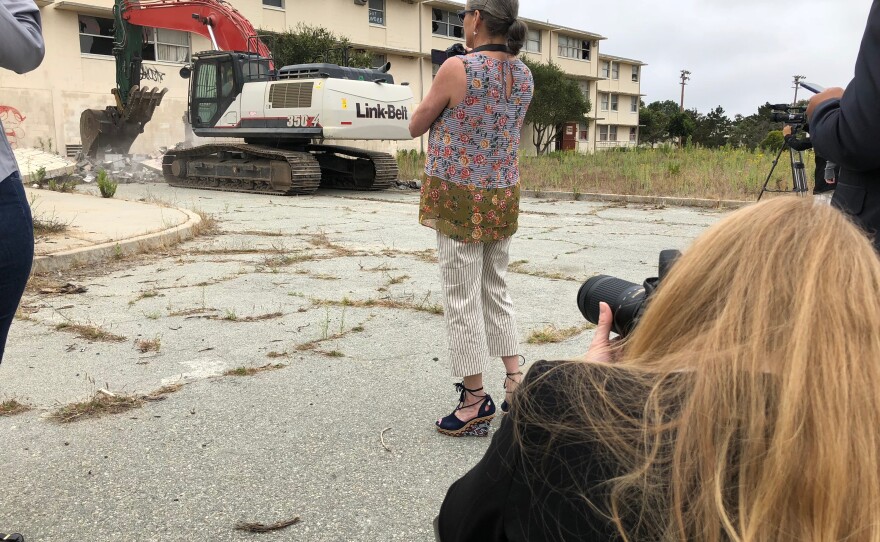It’s been nearly 25 years since Fort Ord closed and the removal of all the blighted buildings may soon be within sight. Another swath of old Army buildings is starting to come down in Seaside.
A small crowd cheers as an excavator tears down a cinder block wall outside an old Army building on the former Fort Ord. Curtains still hang in the broken windows. Graffiti marks its walls inside and out.
“When you see what we're looking at today it just you don't see the future as easily,” Gloria Stearns is Community Development Director for the City of Seaside, which owns the land and its seventeen dilapidated buildings.
“But the plus side is once you get them down that's the sign of progress. So people like to see things getting torn down. When they see empty land then they can start to imagine the future there,” she says.
Stearns and other public officials gathered Wednesday to celebrate the beginning of the future for this 85 acre piece of the former Fort. The land, known as Surplus II, sits south of Cal State Monterey Bay (CSUMB) in between Colonel Durham Street and Giggling Road.
The old, abandoned buildings will be replaced with Campus Town. It’s a mixed use development named for its proximity to neighboring CSUMB and inspired by community input.
“So it'll be a mix of housing commercial opportunity employment opportunities student housing affordable housing,” says Stearns. “They wanted more green space they wanted it to be bicycle friendly they wanted to have places to walk their kids. They wanted places to create jobs.”
This is one of the last few areas of blight on the former Fort Ord. When the government shut down the base back in 1994, the Army left behind 5700 buildings, according to Michael Houlemard, Executive Officer of the Fort Ord Reuse Authority (FORA).
“A lot of them were just little bitty huts or lookout towers or things that didn't really equate but buildings, but there were several thousand very large buildings,” says Houlemard.
80% those buildings have been reused or torn down. But blight remains in some highly visible areas like along Highway 1 in Marina.
“We still have several hundred buildings to go. The cost of removing those several hundred buildings might be 50, 60, 70, 80-million more dollars to get those done,” says Houlemard.
The price is so high in large part because the buildings are contaminated with lead based paint, asbestos and other toxins. All that has to be safely removed before the buildings come down. The cost and responsibility of removal falls on who owns the land.
“That doesn't mean that FORA can't help, and we have voluntarily added from FORA resources, extra dollars to try to get those buildings down. But the obligation really is with the landowner who is developing the property,” says Houlemard.
He adds FORA is working on a plan to tear down the rest.
“Well we'd like to have them all removed before the Fort Ord Reuse Authority goes away, and technically we go away on June 30, 2020,” says Houlemard.
FORA was created by the California Legislature to oversee the recovery of Fort Ord. It was set to dissolve in 2014, but Senator Bill Monning helped get it an extension to June 30, 2020.
Monning says conversations about whether FORA needs another extension are ongoing.
“Some of those decisions will be made as soon as the end of this year or early next year. And I remain agnostic as to whether there will be an extension. I'm not playing games. We're just collecting data and trying to figure out what's the best plan for all the communities that share in this precious resource,” says Senator Monning who also attended Wednesday celebration.
When Fort Ord closed it left behind an area of land roughly the size of San Francisco. That land has been divided up between a number of entities like the U.S. Bureau of Land Management (Fort Ord National Monument), California State Parks (Fort Ord Dunes State Park) and CSUMB.
Surrounding communities, like Marina and Seaside, also received property. Seaside gained possession of the for the proposed Campus Town land back in 2005.
“You know this area may be one of the central pieces of Fort Ord recovery for the future. It's right at the main gate entrance to the former Fort it is a key parcel in the overall recovery,” says Houlemard. “So clearing the buildings out of the way and enabling the Campus Town development to proceed in a way that focuses attention on the next several centuries is crucial to our whole recovery.”
Jobs are another key component of recovering from the loss of Fort Ord. Since the base closed, about 4,000 jobs have been created. Houlemard says that number needs to be closer to 12,000.
The Campus Town development in Seaside aims to help there too. Seaside’s Gloria Stearns says there will be space for business to relocate or grow locally.
“We hate to see kids get degrees from CSUMB and have to leave. We want them to be able to stay here and create businesses,” says Stearns.
Removal of the dilapidated buildings on the site of the planned Campus Town is expected to be complete in a year.










